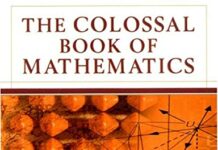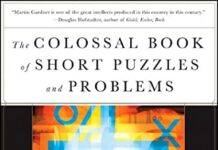
Ebook Info
- Published: 2033
- Number of pages: 208 pages
- Format: PDF
- File Size: 7.77 MB
- Authors: Martin Gardner
Description
Why do card tricks work? How can magicians do astonishing feats of mathematics mentally? Why do stage “mind-reading” tricks work? As a rule, we simply accept these tricks and “magic” without recognizing that they are really demonstrations of strict laws based on probability, sets, number theory, topology, and other branches of mathematics.This is the first book-length study of this fascinating branch of recreational mathematics. Written by one of the foremost experts on mathematical magic, it employs considerable historical data to summarize all previous work in this field. It is also a creative examination of laws and their exemplification, with scores of new tricks, insights, and demonstrations. Dozens of topological tricks are explained, and dozens of manipulation tricks are aligned with mathematical law.Nontechnical, detailed, and clear, this volume contains 115 sections discussing tricks with cards, dice, coins, etc.; topological tricks with handkerchiefs, cards, etc.; geometrical vanishing effects; demonstrations with pure numbers; and dozens of other topics. You will learn how a Moebius strip works and how a Curry square can “prove” that the whole is not equal to the sum of its parts.No skill at sleight of hand is needed to perform the more than 500 tricks described because mathematics guarantees their success. Detailed examination of laws and their application permits you to create your own problems and effects.
User’s Reviews
Editorial Reviews: From the Back Cover Why do card tricks work? How can magicians do astonishing feats of mathematics mentally? Why do stage “mind-reading” tricks work? As a rule, we simply accept these tricks and “magic” without recognizing that they are really demonstrations of strict laws based on probability, sets, number theory, topology, and other branches of mathematics.This is the first book-length study of this fascinating branch of recreational mathematics. Written by one of the foremost experts on mathematical magic, it employs considerable historical data to summarize all previous work in this field. It is also a creative examination of laws and their exemplification, with scores of new tricks, insights, and demonstrations. Dozens of topological tricks are explained, and dozens of manipulation tricks are aligned with mathematical law.Nontechnical, detailed, and clear, this volume contains 115 sections discussing tricks with cards, dice, coins, etc.; topological tricks with handkerchiefs, cards, etc.; geometrical vanishing effects; demonstrations with pure numbers; and dozens of other topics. You will learn how a Moebius strip works and how a Curry square can “prove” that the whole is not equal to the sum of its parts.No skill at sleight of hand is needed to perform the more than 500 tricks described because mathematics guarantees their success. Detailed examination of laws and their application permits you to create your own problems and effects. About the Author Martin Gardner was a renowned author who published over 70 books on subjects from science and math to poetry and religion. He also had a lifelong passion for magic tricks and puzzles. Well known for his mathematical games column in Scientific American and his “Trick of the Month” in Physics Teacher magazine, Gardner attracted a loyal following with his intelligence, wit, and imagination. Martin Gardner: A Remembrance The worldwide mathematical community was saddened by the death of Martin Gardner on May 22, 2010. Martin was 95 years old when he died, and had written 70 or 80 books during his long lifetime as an author. Martin’s first Dover books were published in 1956 and 1957: Mathematics, Magic and Mystery, one of the first popular books on the intellectual excitement of mathematics to reach a wide audience, and Fads and Fallacies in the Name of Science, certainly one of the first popular books to cast a devastatingly skeptical eye on the claims of pseudoscience and the many guises in which the modern world has given rise to it. Both of these pioneering books are still in print with Dover today along with more than a dozen other titles of Martin’s books. They run the gamut from his elementary Codes, Ciphers and Secret Writing, which has been enjoyed by generations of younger readers since the 1980s, to the more demanding The New Ambidextrous Universe: Symmetry and Asymmetry from Mirror Reflections to Superstrings, which Dover published in its final revised form in 2005. To those of us who have been associated with Dover for a long time, however, Martin was more than an author, albeit a remarkably popular and successful one. As a member of the small group of long-time advisors and consultants, which included NYU’s Morris Kline in mathematics, Harvard’s I. Bernard Cohen in the history of science, and MIT’s J. P. Den Hartog in engineering, Martin’s advice and editorial suggestions in the formative 1950s helped to define the Dover publishing program and give it the point of view which — despite many changes, new directions, and the consequences of evolution — continues to be operative today. In the Author’s Own Words:”Politicians, real-estate agents, used-car salesmen, and advertising copy-writers are expected to stretch facts in self-serving directions, but scientists who falsify their results are regarded by their peers as committing an inexcusable crime. Yet the sad fact is that the history of science swarms with cases of outright fakery and instances of scientists who unconsciously distorted their work by seeing it through lenses of passionately held beliefs.” “A surprising proportion of mathematicians are accomplished musicians. Is it because music and mathematics share patterns that are beautiful?” — Martin Gardner
Reviews from Amazon users which were colected at the time this book was published on the website:
⭐I’ve spent many years studying both magic and mathematics (separately and together). When it comes to joining these fields together, there have been a number of important individuals who’ve made a number of important contributions, but Martin Gardner is the grandfather of us all. This book represents a treasury of over a hundred mathematical magic tricks, more than enough to keep the reader busy for years.The wonderful thing about this book is its scope. Despite being a relatively short book, it covers a lot of territory, featuring mathematical magic tricks using a wide range of props ranging from mere numbers themselves to playing cards and ropes and much more. If you want the largest collection of mathematical trickery I’ve ever seen conveniently presented in a single reference, this is the book for you.However, if you’re looking for a detailed exploration of the mathematics behind those tricks, you may be disappointed. While Gardner’s other works clearly demonstrate that he was up to the task, he didn’t provide much mathematical depth in this book. It’s a rare page that even contains a single equation. The result is a book that, though it covers mathematical ground, is much better suited to the amateur magician than to the amateur mathematician.
⭐If you’re new to Gardner’s mathematical writing, this is a great place to start. The theme for Mathematics Awareness Month 2014 is taken from this book (visit mathaware.org to see the result), and fun as that site is to explore this book really has it all. Gardner has a clear, inviting style that is disarming in its directness. Yet he takes you almost immediately to strange and wonderful places that truly show off the beauty of abstract mathematical ideas. What a ride. I’ve had a ball rediscovering this classic book.
⭐This is a lot of information, well presented, in a compact source. As a pro magician & an educational assembly performer, I can use this as a quick source for material to use in my shows.
⭐One of a kind puzzle book. Wonderful illustrations, entertaining and stimulating writing. Good mix of puzzles, with well-organized chapters. I owned this 60 years ago, when I was a teen! And I still like it.
⭐This was not what I was expecting.
⭐Great product!
⭐I was expecting something different from this book. After taking a math workshop, I purchased this book based on a suggestion from a person attending. I wanted a book that was slightly more user friendly than this one. I have not used it because each time I looked at the title expect to be able to open it up to discover a great math trick I then open the book and find the text dry and dull. I placed the book in my free time area thinking it would be great for advanced students, however after 4 years no one picked it up. I know Martin Gardner is a brilliant author, but this one was too much for me.
⭐My 12 year old who loves math and science cannot get enough of these books. I highly recommend this author.
⭐I’ve been learning about magic squares and a friend found this book for himself in a book shop. I bought it from eBay and it’s amazing! It gives some great insight into the history of the squares and shows some really cool ways to create them. I’ve edifies my knowledge by reading it.
⭐A great book
⭐This is a must-have item if you are interested in mentalism and/or mental magic.
⭐It’s a Martin Gardner book. What more do you need to know? The man’s a legend. All his stuff is entertaining.
⭐Great fun and very clever
Keywords
Free Download Mathematics, Magic and Mystery (Dover Recreational Math) in PDF format
Mathematics, Magic and Mystery (Dover Recreational Math) PDF Free Download
Download Mathematics, Magic and Mystery (Dover Recreational Math) 2033 PDF Free
Mathematics, Magic and Mystery (Dover Recreational Math) 2033 PDF Free Download
Download Mathematics, Magic and Mystery (Dover Recreational Math) PDF
Free Download Ebook Mathematics, Magic and Mystery (Dover Recreational Math)

